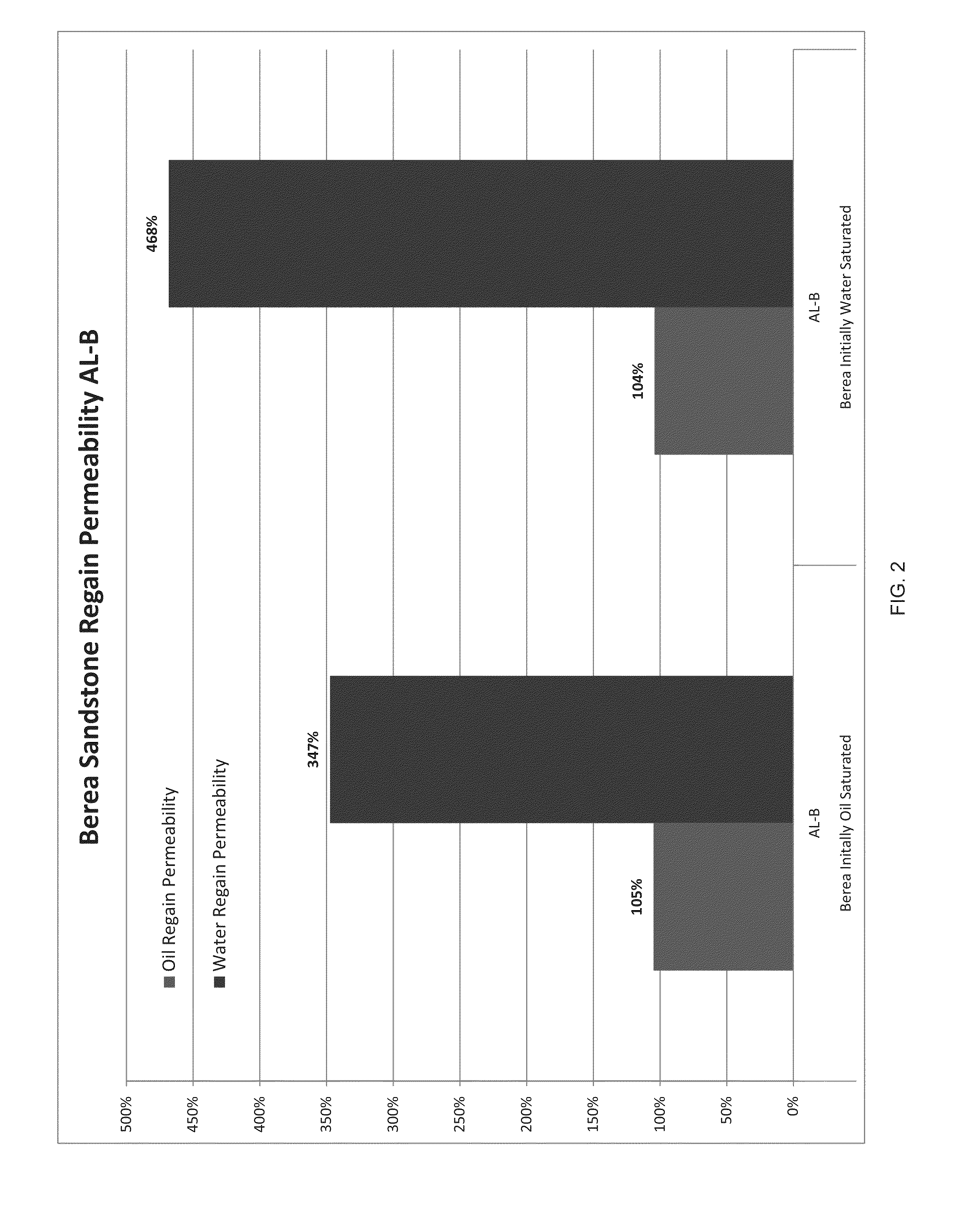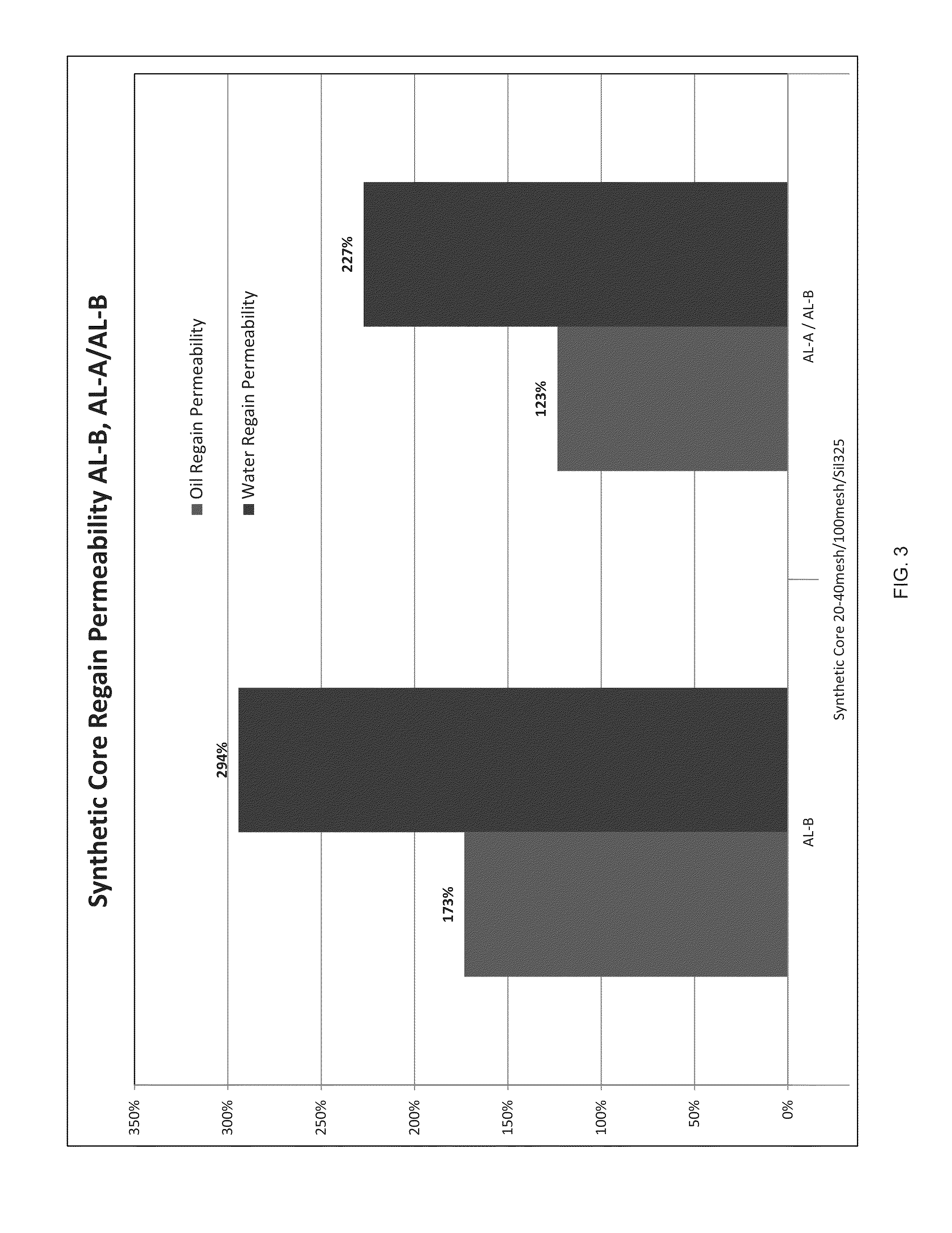Method of using surface modifying treatment agents to treat subterranean formations
a technology of surface modification and treatment agent, which is applied in the direction of borehole/well accessories, folding cabinets, cabinets, etc., can solve the problems of increasing the cost of well production, and reducing the effect of drag reduction gel, so as to reduce the retention of water, prevent or greatly inhibit the swelling of clay, and increase the relative permeability to oil/gas withou
- Summary
- Abstract
- Description
- Claims
- Application Information
AI Technical Summary
Benefits of technology
Problems solved by technology
Method used
Image
Examples
example 1
[0124]Berea sandstone cores measuring 1.0″ in diameter and 1.5″ in length and having nitrogen permeability of 200 and were evacuated with air and then saturated with either 2% aqueous solution of potassium chloride (KCl) or ISOPAR™ paraffinic fluid of ExxonMobil Chemical Company. The core was then installed in a hydrostatic core holder apparatus. Approximately 200 psi back pressure was applied at the exit end and approximately 1,000 psi confining stress (overburden pressure) was applied around the entire cylinder. The confining stress pressure simulated stress in the downhole formation. When saturated with KCl, a flow of the paraffinic fluid was flowed through the core in order to establish a base line permeability to the core to the oil followed by a flow of KCl solution to establish a baseline permeability to water. When saturated with the paraffinic fluid, a flow of the KCl solution was flowed through the core in order to establish a base line permeability to the core to the wate...
example 2
[0127]Permeability testing was performed on a synthetic core composed of 20-40 mesh gravel, 100 mesh sand and 325 mesh silica. The 325 mesh silica mimics fines in formations. The synthetic core was 1.0″ in diameter and 2.0″ in length and having nitrogen permeability of 100 and was saturated with 2% aqueous solution of potassium chloride (KCl). The core was then installed in a hydrostatic core holder apparatus. Approximately 200 psi back pressure was applied at the exit end and approximately 1,000 psi confining stress (overburden pressure) was applied around the entire cylinder. The confining stress pressure simulated stress in the downhole formation. ISOPAR™ paraffinic fluid was then flowed through the core in order to establish a base line permeability to the core to the oil. When saturated with the paraffinic fluid, a flow of the KCl solution was flowed through the core. Pressure drop was measured across the entire length of the core and was used to calculate individual baseline p...
example 3
[0130]The effect of surface modifying treatment agents on water and hydrocarbons was determined for three substrates. Each of the surface modifying treatment agents had a hydrophobic tail and an anchor. The anchor through a covalent bond secures the surface modifying treatment agent onto the surface of the substrate. The surface modifying treatment agents were H1-F and Aculon E [comprising 2% of a treatment agent having a transition metal (anchor) linked to a fluorinated hydrocarbon tail in an organic solvent] and AL-B [comprising 2% of an organophosphonate (anchor) having a hydrocarbon polymeric hydrophobic tail in an organic solvent blend]; all commercially available from Aculon, Inc. Aculon-E and AL-B exhibited hydrophobic and oleophobic properties while H1-F exhibited hydrophobic properties only.
[0131]The surface modifying treatment agent was sprayed onto a glass slide (having a more homogeneous surface than natural rock), a core of Ohio sandstone and a core of Berea sandstone t...
PUM
 Login to View More
Login to View More Abstract
Description
Claims
Application Information
 Login to View More
Login to View More - R&D
- Intellectual Property
- Life Sciences
- Materials
- Tech Scout
- Unparalleled Data Quality
- Higher Quality Content
- 60% Fewer Hallucinations
Browse by: Latest US Patents, China's latest patents, Technical Efficacy Thesaurus, Application Domain, Technology Topic, Popular Technical Reports.
© 2025 PatSnap. All rights reserved.Legal|Privacy policy|Modern Slavery Act Transparency Statement|Sitemap|About US| Contact US: help@patsnap.com



